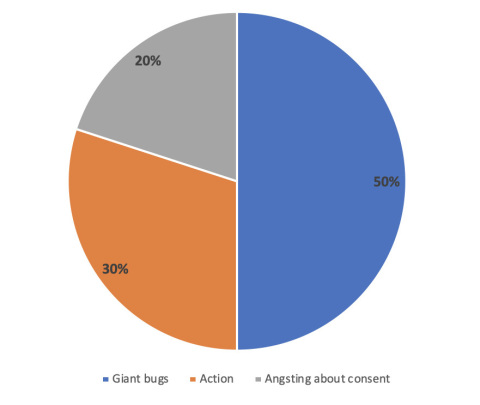Cell phones send out a signal that makes everyone who hears it turn into ravening zombies!
Stephen King often starts out with "ordinary thing X is scary" and then takes that premise in interesting directions. So it didn't put me off that the premise of Cell is "cell phones are scary," because he's done great things with "a car is scary," "a Saint Bernard is scary," "a devoted fan is scary," etc.
The problem with Cell isn't that cell phones aren't scary, or that the book is basically "old man yells at cell phones." It's that though there are individual good scenes and good characters, the premise goes in nonsensical directions, the characters are subpar, and the book as a whole doesn't work.
The opening scene, in which the one guy in a park without a cell phone watches helplessly while everyone who answers or makes a phone call goes berserk, is a grabber. But it also ends up illustrating why King normally doesn't do big action scenes as openers. Everyone's running around attacking each other or trying to escape, and we know nothing about any of them, so it's exciting but in a hollow way. In most King books there'd be more buildup - sometimes a LOT more buildup - so you care about the characters and are biting your nails in anticipation of the phone zombies, rather than the phone zombies attacking on page one.
The no-phone guy is Clay, a comic book artist/writer who's in New York to pitch his comic, while his estranged wife and beloved son are home in Maine. Normally I either love King's protagonists or find them awful but compelling. Very unusually for King, I didn't care about Clay.
There's a lack of specific details on what his wife and son are like as people, so Clay's quest to find them lacks emotion. He also just doesn't have much personality. Clay hooks up with a gay guy, Tom, and a teenage girl, Alice, to avoid phone zombies and find his family. I did like Tom and Alice, but the entire book is from Clay's POV. This book particularly would have benefited from multiple POVs as everything outside of Clay seemed more interesting than Clay.
But mostly I want to rant a bit about how the phone zombie plot is aggressively nonsensical.
( Read more... )
Really bottom-tier King. I rank it with Thinner and The Tommyknockers in my absolute least favorites. (I have not read Dreamcatcher.) If you like King in general, which are your least favorites of his?
Check out the covers. The first is the original, showing a flip-top phone. (Also an overturned cup and a scary shadow, both of which detract from rather than add to the central image. The artist definitely caught the "throw in things randomly" vibe of the book.) The second one shows a modern phone. If you read this book picturing a modern cell phone, you will be very confused as they are only ever used for phone calls, not accessing the internet.




Stephen King often starts out with "ordinary thing X is scary" and then takes that premise in interesting directions. So it didn't put me off that the premise of Cell is "cell phones are scary," because he's done great things with "a car is scary," "a Saint Bernard is scary," "a devoted fan is scary," etc.
The problem with Cell isn't that cell phones aren't scary, or that the book is basically "old man yells at cell phones." It's that though there are individual good scenes and good characters, the premise goes in nonsensical directions, the characters are subpar, and the book as a whole doesn't work.
The opening scene, in which the one guy in a park without a cell phone watches helplessly while everyone who answers or makes a phone call goes berserk, is a grabber. But it also ends up illustrating why King normally doesn't do big action scenes as openers. Everyone's running around attacking each other or trying to escape, and we know nothing about any of them, so it's exciting but in a hollow way. In most King books there'd be more buildup - sometimes a LOT more buildup - so you care about the characters and are biting your nails in anticipation of the phone zombies, rather than the phone zombies attacking on page one.
The no-phone guy is Clay, a comic book artist/writer who's in New York to pitch his comic, while his estranged wife and beloved son are home in Maine. Normally I either love King's protagonists or find them awful but compelling. Very unusually for King, I didn't care about Clay.
There's a lack of specific details on what his wife and son are like as people, so Clay's quest to find them lacks emotion. He also just doesn't have much personality. Clay hooks up with a gay guy, Tom, and a teenage girl, Alice, to avoid phone zombies and find his family. I did like Tom and Alice, but the entire book is from Clay's POV. This book particularly would have benefited from multiple POVs as everything outside of Clay seemed more interesting than Clay.
But mostly I want to rant a bit about how the phone zombie plot is aggressively nonsensical.
( Read more... )
Really bottom-tier King. I rank it with Thinner and The Tommyknockers in my absolute least favorites. (I have not read Dreamcatcher.) If you like King in general, which are your least favorites of his?
Check out the covers. The first is the original, showing a flip-top phone. (Also an overturned cup and a scary shadow, both of which detract from rather than add to the central image. The artist definitely caught the "throw in things randomly" vibe of the book.) The second one shows a modern phone. If you read this book picturing a modern cell phone, you will be very confused as they are only ever used for phone calls, not accessing the internet.




